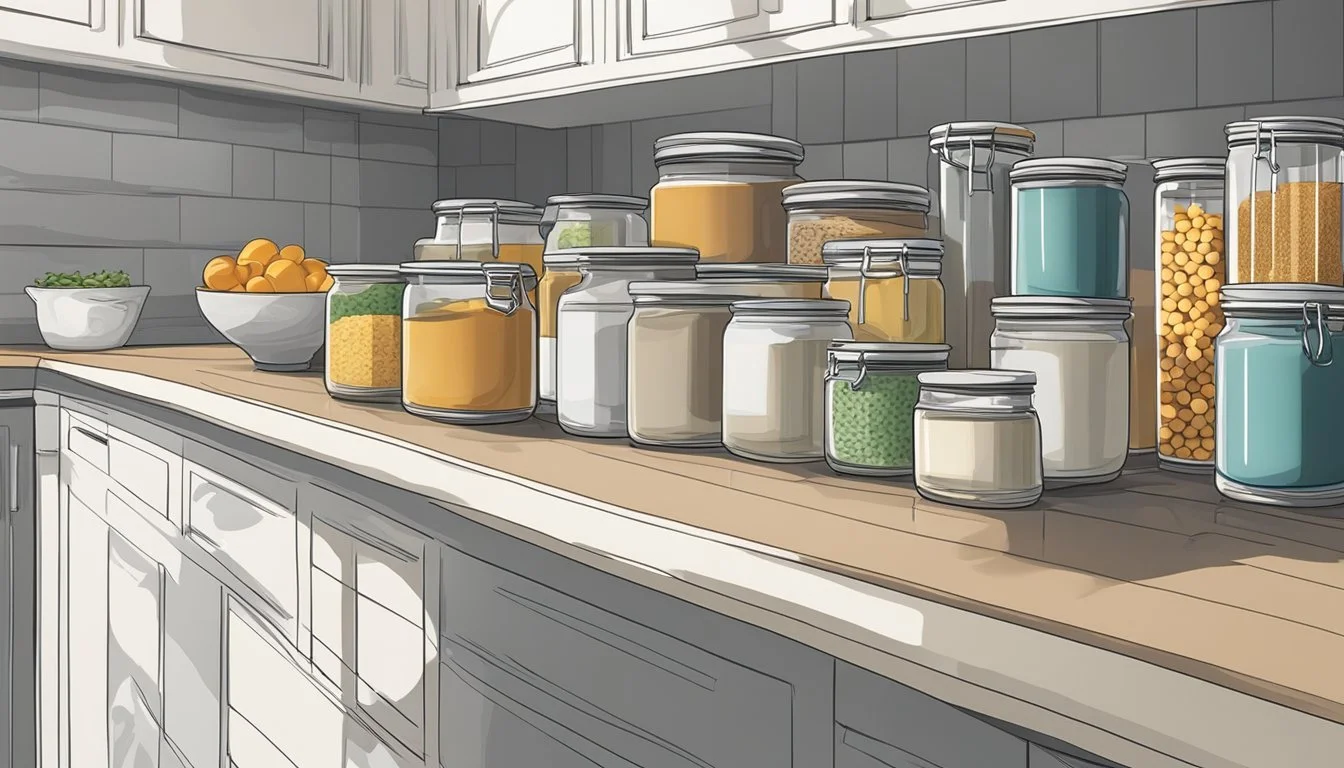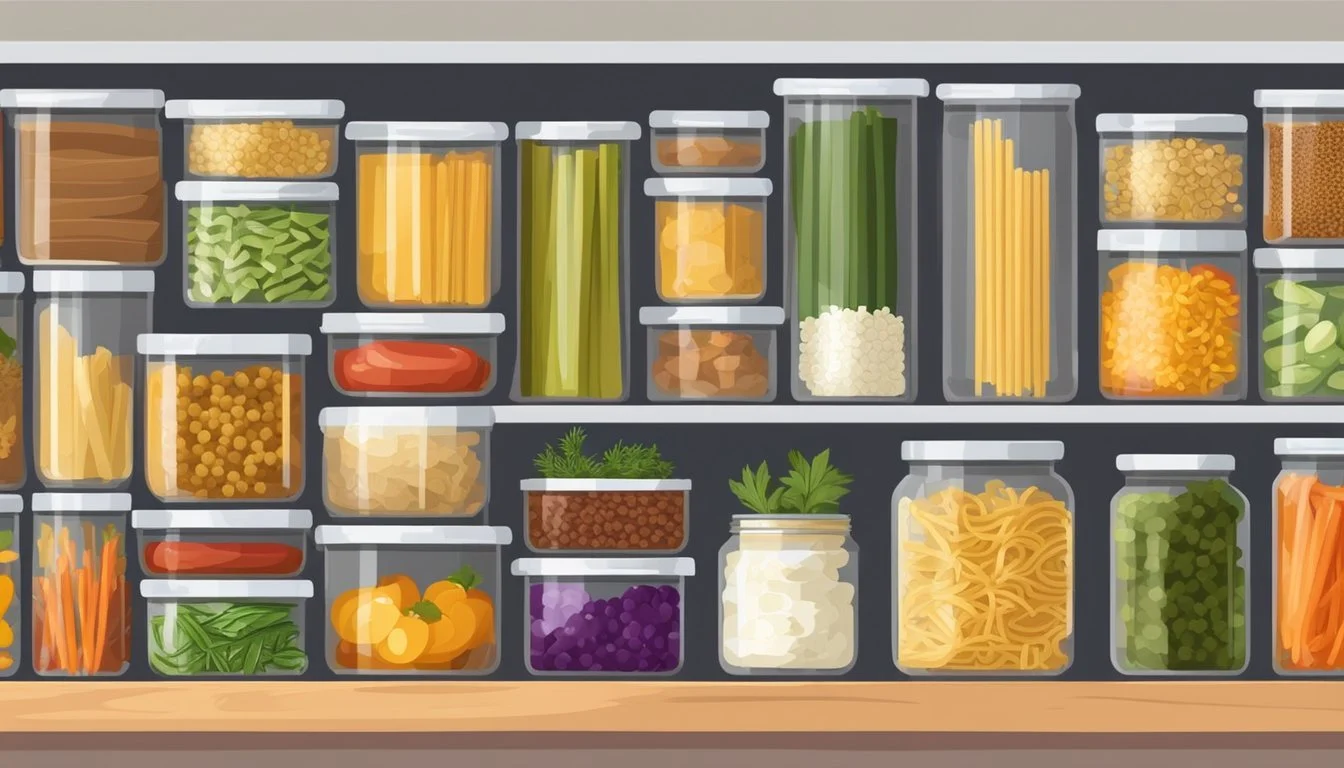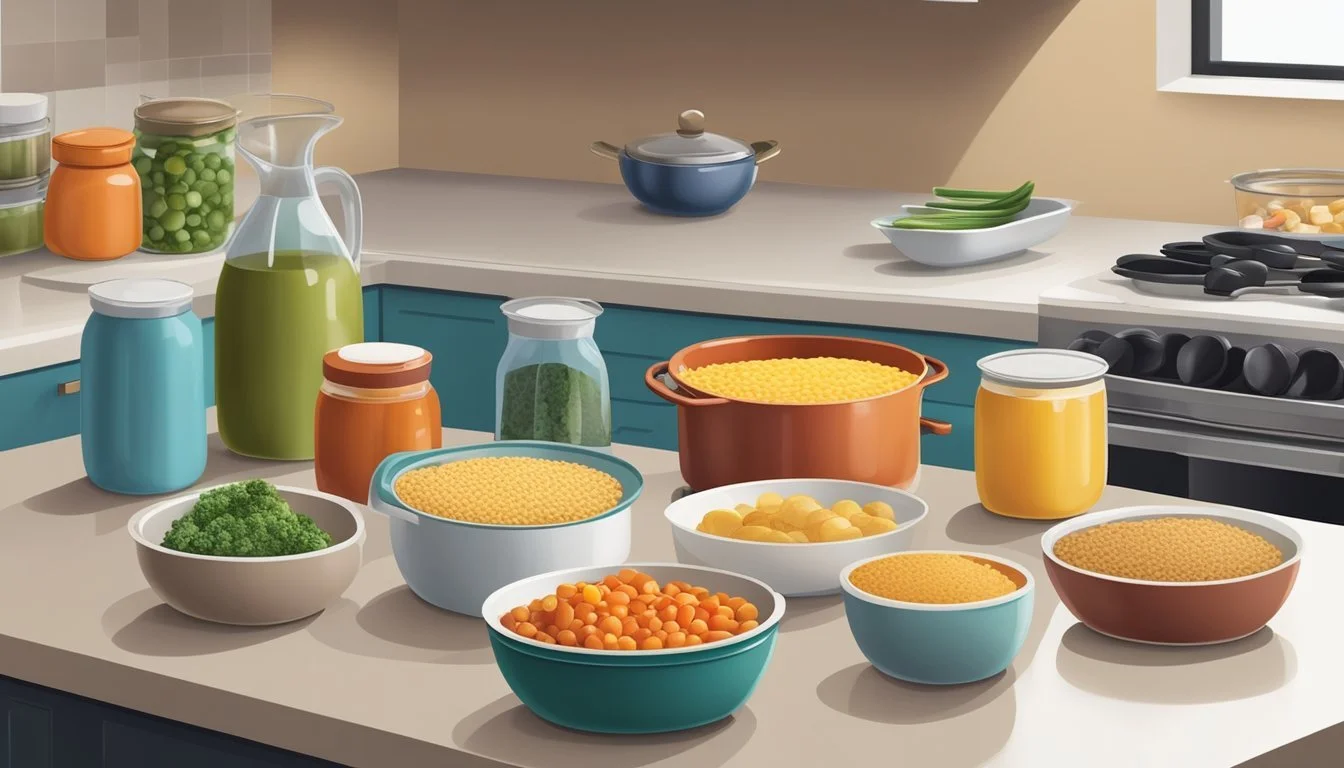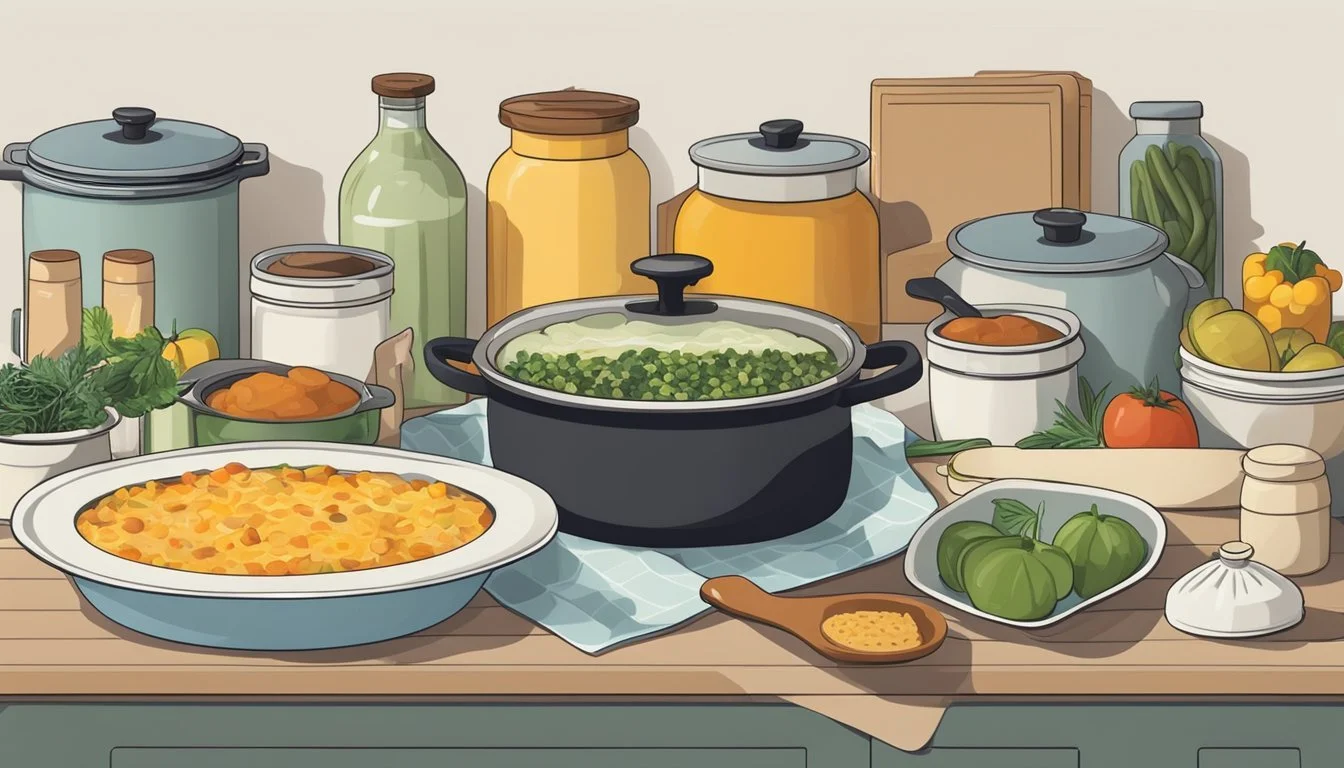Pantry-Friendly Casseroles
Easy Recipes Using Shelf-Stable Ingredients
Casseroles (What wine goes well with casseroles?) have long been a staple of home cooking, offering a comforting blend of flavors and textures in a single dish. Their heartiness and simplicity make them perennial favorites, especially when time or resources are limited. Pantry-friendly casseroles, in particular, are ingenious solutions that rely on non-perishable items from the pantry. These dishes often incorporate canned or frozen vegetables, dried pasta, and rice, which are combined with a few fresh ingredients to create meals that are both satisfying and convenient.
The versatility of pantry-friendly casseroles allows for a wide array of options, from classic combinations to innovative pairings. These one-dish wonders can be tailored to fit any taste or dietary requirement, with variations including vegetarian polenta bakes, protein-rich chicken enchiladas, (What wine goes well with chicken enchiladas?) and comforting mac and cheese. The convenience of a casserole lies not just in its preparation, but also in its ability to be made ahead of time, making it an ideal choice for busy weeknights or unexpected guests.
Furthermore, the adaptability of casseroles means that they can be easily modified to use what is already available in the kitchen, reducing food waste and saving a trip to the grocery store. Whether it's transforming that jar of Alfredo sauce into a delightful supper or turning pantry essentials into a delicious pasta bake, these recipes are resourceful and economical. In essence, pantry-friendly casseroles are the perfect marriage of ease and comfort, providing home cooks with reliable and enjoyable meals any day of the week.
Choosing the Right Ingredients
Creating a casserole from pantry staples relies on selecting ingredients that will combine to create a flavorful and cohesive dish. Choosing the right types of cheese, proteins, vegetables, grains, and seasonings can turn basic ingredients into a delicious homemade meal that is both easy and quick to make.
Types of Cheese
Sharp Cheddar: Adds a tangy, rich flavor and melts well. Ideal for a robust taste.
Parmesan: Offers a nutty and salty taste, perfect for topping and baking.
Gouda & Smoked Cheddar: Provide a smoky flavor to the dish.
Monterey & Pepper Jack: Spice up casseroles with a hint of heat.
Colby & Havarti: Milder options that still contribute creaminess.
Selecting Proteins
Chicken Breast (What wine goes well with chicken breast?): A versatile protein that pairs well with myriad ingredients.
Ground Beef: Makes for a hearty casserole base, especially when browned.
Italian Sausage: Infuses a spicy and herby profile into the dish.
Ham: A good choice for adding a savory, salty aspect.
Vegetables and Legumes
Broccoli & Cauliflower: Offer texture and fibrous content.
Mushrooms & Onions: Contribute umami and sweetness respectively.
Spinach & Zucchini: Introduce a mild flavor and additional nutrients.
Peas & Carrots: For a touch of color and sweetness.
Grains and Pasta Selection
Rice: Brown rice provides a nutty flavor and whole-grain benefits.
Pasta: Use pasta for a classic casserole base; consider shapes that hold sauce well.
Herbs and Seasonings
Salt & Black Pepper: Fundamental for seasoning; add to taste.
Parsley & Paprika: For color and a mild herbaceous note.
Onion Powder & Garlic Powder: Enhance overall savoriness without fresh produce.
Creating a Flavor Base
Olive Oil & Butter: Serve as the starting point for layering flavors.
Cream of Chicken & Chicken Broth: Build a creamy texture and a savory backdrop.
Dijon Mustard & Chicken Bouillon: Introduce depth and complexity.
Gluten-Free Alternatives
Gluten-Free Pasta: Offers a suitable base for those avoiding gluten.
Cornstarch: Can replace flour for thickening to maintain a gluten-free status.
Finding Substitutes for Common Allergens
Dairy-Free Cheese: For those with lactose intolerance, various non-dairy options are available.
Cream of Mushroom Soup: Often found in recipes, can be substituted with allergy-friendly cream soups.
Preparation Techniques
Creating pantry-friendly casseroles involves several preparation techniques to ensure that the dish is flavorful, has the right texture, and is comforting. Knowing how to properly prep your ingredients will make the casserole-making process more efficient and result in a better-tasting dish.
Cooking Pasta and Grains
Pasta and grains serve as the base for many casserole recipes. To ensure they are tender and not overcooked in the casserole, pre-cook pasta to al dente in boiling water. Grains like rice can be cooked according to package instructions, but typically they should also be slightly undercooked since they'll continue to cook in the oven.
Handling and Prepping Meat
Properly preparing meat is crucial for a juicy and flavorful casserole. For chicken, it's often recommended to sear the pieces in a skillet before adding them to the casserole to lock in moisture. Ground beef should be browned and drained of excess fat. Larger beef cuts may need to be cut into bite-sized pieces and browned for tenderness.
Chopping and Preparing Vegetables
Vegetables like broccoli, onions, carrots, and celery often find their way into casserole recipes. They should be chopped into uniform sizes for even cooking. Sautéing them lightly before adding to the casserole helps to soften them and enhance their flavors.
Making Creamy Sauces
To create a rich and creamy sauce that’s a hallmark of comforting casseroles, start by making a roux with butter and flour. Slowly whisk in milk to avoid lumps. For a quicker sauce, cream of chicken or cream of mushroom soup can be used as a base; however, these should be thinned with milk or broth to prevent the casserole from becoming too dense.
Layering and Assembling Casseroles
Assembling in a baking dish typically involves layering the ingredients. Start with a base layer, like pasta or grains, followed by the meat and vegetables. Pour the creamy sauce over the layers and top with cheese, creating a cheesy crust. Each layer should be seasoned to ensure the casserole is flavorful throughout.
Baking and Cooking Methods
Creating the perfect casserole involves understanding specific baking and cooking methods to yield the desired textures, such as tender chicken, creamy cheese blends, or crispy toppings. These methods also ensure that ingredients such as broccoli are well-roasted rather than overcooked.
Oven Baking Tips
When using an oven to bake casseroles, preheating is critical. One should start with a preheated oven to ensure even cooking. Chicken breasts and broccoli should be added to the baking dish at the right stages to avoid drying out or undercooking. For a crunchy topping, one might broil the casserole for the last few minutes until the surface is golden and crispy.
Chicken breasts: Bake until the internal temperature reaches 165°F (74°C).
Broccoli: Cut into even florets for uniform roasting.
Using Alternative Cooking Appliances
Casseroles can also be made in alternative cooking appliances. A skillet is useful for recipes that call for sautéing ingredients before baking, helping ground turkey or chicken breast become juicy and flavorful. Ingredients can be combined directly in the skillet and then transferred into the oven if the skillet is oven-safe. For a no-oven option, slow cookers are capable of cooking casseroles, albeit with longer cook times.
Skillet usage: Start with sautéing for flavor, then add other ingredients, and transfer to the oven if applicable.
Slow cooker conversion: Increase cooking time by several hours on low heat.
Adjusting Cooking Times for Different Ingredients
Different ingredients require varied cooking times to reach the desired consistency. Ground turkey may cook more quickly than diced chicken breast, which can take longer to become tender. Incorporating creamy elements such as cheese or cream-based sauces should ensure they do not separate or curdle under high heat.
Tender chicken: Avoid overcooking by checking doneness with a meat thermometer.
Creamy elements: Add late in the cooking process to prevent separation.
Serving and Presentation
When serving pantry-friendly casseroles, the focus should be on complementing the dish's inherent comfort with appropriate side dishes, enhancing its appeal with tasteful garnishes, and using plating techniques that make it visually appetizing.
Pairing with Side Dishes
Pairing a casserole with the right side dishes can transform it from a simple meal to a well-rounded feast. For a casserole rich in flavors, such as one featuring sharp cheddar cheese, a fresh green salad or a cucumber tomato salad offers a refreshing contrast. If the casserole is hearty and savory, consider lighter sides like a winter fruit salad or warm, buttery dinner rolls.
Garnishing for Enhanced Flavor
Casseroles benefit from garnishes that not only add a pop of color but also complement the dish’s taste profile. Sprinkling freshly grated parmesan can add a savory umami kick, while a garnish of bright parsley provides a fresh, herbaceous note. For casseroles that are meant to be served immediately, even fried rosemary might offer an aromatic element enhancing the dish's overall flavor.
Plating Techniques
The appeal of a casserole can be significantly heightened with thoughtful plating. Serve the casserole in a clean, warm dish and ensure to spoon it neatly onto plates. If the recipe features a cheesy, bubbly crust, scoop from the edges to include this prized element. For a decorative touch, a light dusting of dried parsley over the plated servings can make the dish look professionally done and inviting.
Storage and Leftovers
When considering storage and leftovers for pantry-friendly casseroles, one must ensure that foods are cooled, refrigerated, or frozen properly to maintain freshness and prevent foodborne illnesses.
Proper Cooling and Refrigeration
Immediately after serving, leftovers should be allowed to cool to room temperature within two hours before refrigeration. In the fridge, a well-sealed container is crucial to keep savory cheesy, comforting casseroles fresh. Refrigeration should be at or below 40°F (4°C), and leftovers are best consumed within 3-4 days to retain the satisfying taste and texture.
Freezer-Friendly Casseroles
For longer storage, many casseroles are freezer-friendly, which makes them an easy and quick meal prep option. To freeze, one must wrap the casserole dish tightly in aluminum foil or plastic wrap, and for best quality, consume within 2-3 months. Cheesy casseroles generally freeze well, but it's vital to wrap them tightly to prevent freezer burn.
Reheating without Drying Out
When reheating leftovers, moisture is key to avoid drying out the dish. Covering the casserole with foil while reheating in the oven can help retain moisture. For microwave reheating, adding a splash of water or broth can bring back the comforting texture and warmth of the original dish.
Safely Storing Vegetable-Based Casseroles
Vegetable-based casseroles should be stored with care as veggies can become soggy if stored improperly. Make sure they are in airtight containers and consume within a couple of days to enjoy their peak satisfying quality. If the vegetable casserole includes cheese, ensure the cheesy top layer is protected from direct contact with the container's lid to maintain its appealing crispness.
Health and Nutrition Considerations
Pantry-friendly casseroles offer a convenient and often nutritious option for meals, but certain health considerations are important when preparing these dishes. Focusing on nutrient balance, reducing unhealthy fats and sodium, and being mindful of special dietary needs and portion sizes can elevate the healthfulness of your casserole.
Balancing your Casserole with Nutrients
To create a nutrient-dense casserole, one must ensure that it includes a combination of proteins, carbohydrates, and fats. Protein sources such as quinoa or lean ground beef can provide the body with essential amino acids, while choosing complex carbohydrates like brown rice offers sustained energy. A modest amount of cheese adds calcium and flavor, but should be used judiciously to control fat content.
Reducing Sodium and Fats
Sodium and saturated fats are often high in traditional casseroles. Opting for low sodium broths and using spices for flavor rather than salt can significantly reduce sodium content. Replacing butter with olive oil not only decreases saturated fat but also introduces heart-healthy monounsaturated fats into the dish. Similarly, choosing part-skim or reduced-fat cheese variants helps to lower overall fat intake.
Incorporating More Vegetables
Vegetables such as broccoli, carrots, mushrooms, peas, cauliflower, and zucchini not only infuse dishes with vitamins and minerals but also contribute to the overall volume, adding bulk without excessive calories. Such additions make casseroles more filling and nutritionally diverse.
Options for Special Diets
For those requiring gluten-free or diabetes-friendly options, using gluten-free pasta and brown rice can make a casserole suitable for their dietary restrictions. Incorporating lean proteins and using complex carbs in moderation aids in maintaining blood sugar levels. Non-dairy cheese alternatives can also be used to cater to dairy-free diets.
Calculating Portions and Calories
Understanding and controlling portions is key to maintaining a healthy diet. One can calculate the calories per serving by adding up the caloric value of each ingredient and dividing by the number of servings. This also allows individuals to adjust portion sizes based on their specific dietary needs, ensuring that they are not overeating even healthy ingredients.
Creative Variations and Customizations
Creative customizations can transform traditional casserole recipes into unique and flavorful dishes. With simple ingredient swaps and additions, one can easily tailor casseroles to meet personal tastes or to use what’s available in the pantry.
Twists on Traditional Recipes
Classic casserole recipes serve as the perfect starting point for innovation. For example, adding Italian sausage to a traditional lasagna imbues it with a hearty and savory depth, while a sprinkle of Parmesan incorporates a sharp umami kick.
Incorporating International Flavors
Casseroles can travel the globe with the right spices and ingredients. Mix in curry powder for an Indian twist, or use soy sauce and ginger for an Asian flair. A casserole with a base of rice and chicken can be enhanced with these flavors for a globally-inspired meal.
Personalizing Vegetable Combinations
Casseroles are a great vehicle for a variety of vegetables. One can mix green beans, asparagus, and other veggies to add color and nutrition. Experimenting with seasonal produce can also bring freshness to a comforting dish.
Experimenting with Different Cheeses
Different cheeses melt and blend in unique ways, making them perfect for experimentation. Gruyère and Asiago offer a more sophisticated profile, while Gouda and smoked cheddar contribute a distinctive smokiness. Mixing cheeses like Monterrey, pepper jack, havarti, and colby creates layers of creamy, satisfying flavor.
Adding Crunch with Toppings
Toppings can add texture and contrast to the creamy consistency typical of casseroles. Panko breadcrumbs or crushed crackers sprinkled on top before baking provide a crispy, golden crust that complements the soft interior.
Making Casseroles for Special Occasions
For holidays or celebrations, casseroles can be made luxurious and special. To elevate the dish, one might consider layering in truffle oil, using more exotic cheeses, or adding a splash of wine to the base for an enriched flavor.
Transforming Leftovers into New Dishes
Leftover ingredients like chicken breast, beef, or ham are perfect for repurposing into a comforting casserole. This not only minimizes waste but also stimulates creativity in the kitchen, as one seeks to craft a satisfying meal from scratch with what’s already on hand.
Troubleshooting Common Issues
When creating pantry-friendly casseroles, three common issues cooks often face involve the dish's moisture level, sogginess of pasta or rice, and achieving uniform cooking and browning. These subsections provide clear solutions tailored specifically for these concerns.
Casserole Too Dry or Too Wet
A casserole that is too dry lacks sufficient moisture, often in the form of sauce or liquid ingredients. To rectify a dry casserole, one can add more sauce, such as a simple cream or marinara sauce. For instance, crushed canned tomatoes seasoned with salt, pepper, and olive oil can be heated and added.
Conversely, a casserole that is too wet can be improved by incorporating ingredients that absorb excess moisture. This can involve dusting protein with flour before adding it to the casserole, or mixing a slurry of cornstarch and milk into the dish if it's already been assembled.
Preventing Sogginess in Pasta and Rice
Pasta and rice in casseroles can become soggy if they cook for too long or absorb too much liquid. To prevent this:
Pasta: Cook pasta al dente before incorporating it into the casserole, as it will continue to cook in the oven.
Rice: Use long-grain varieties that hold their shape well and undercook them slightly prior to baking.
In both cases, ensuring that the ratio of liquid to solid ingredients is correct is key to preventing a soggy outcome.
Ensuring Even Cooking and Browning
Achieving even cooking and browning in a casserole requires a balanced oven temperature and proper ingredient layering.
Oven temperature: Set between 350°F to 375°F for consistent cooking throughout.
Layering: Place cheese or breadcrumb toppings on last to allow them to become crispy and golden.
For casseroles prone to uneven cooking, such as those with dense ingredients, stirring halfway through baking can ensure that heat penetrates evenly. A crisp, cheesey, and browned top layer often signifies a properly cooked casserole.
Final Thoughts and Tips
When creating pantry-friendly casseroles, one can harness the simplicity and comfort these dishes offer. Utilizing staple ingredients allows for both easy and quick meal preparation, often making them a go-to for busy weeknights.
Opt for Versatility: Pasta casseroles are a prime example of adaptability, as they can be made with various types of noodles and sauces. Remember, whole grain pasta can be a healthier choice and equally satisfying.
Save Time: Canned soups can serve as a flavorful and creamy base, expediting the cooking process. Ensure to check the sodium content if one is health-conscious.
Incorporating vegetables like broccoli can not only boost the nutritional profile but also add texture and flavor to the casserole. A broccoli casserole, for instance, becomes a delightful dish when tossed with a touch of cheese.
Cheese Matters: Speaking of cheese, it can transform a simple casserole into indulgent comfort food. A dash of sharp cheddar or a sprinkle of mozzarella can add depth to any recipe.
Lastly, always preheat the oven and be sure to follow the baking time specified in the recipe to prevent under or overcooking. Each casserole has its unique charm, and with these tips, their preparation can be both effortless and enjoyable.
Frequently Asked Questions
What temperature should the oven be set to for most casseroles? Most casseroles are baked at a moderate temperature, typically around 350°F. However, it's essential to refer to the specific recipe as temperatures may vary based on ingredients and dish size.
Is salt necessary in casserole recipes? Salt is a key seasoning that enhances the flavors of the ingredients. It should be added according to taste, but it's advisable to start with a small amount and adjust as needed, especially if other components contain sodium.
How can I incorporate water into a casserole? Water is generally used sparingly in casseroles, primarily to cook rice or pasta before adding it to the dish. Too much water can result in a soggy casserole.
What is the best way to store casserole leftovers? Leftovers should be cooled to room temperature, then covered or transferred to an airtight container before being refrigerated. This helps maintain freshness and prevents contamination.
Can casseroles be frozen for later use? Many casseroles freeze well and can be a great make-ahead meal option. To freeze, one should wrap the dish tightly with foil or store it in a freezer-safe container. It's recommended to thaw overnight in the refrigerator before reheating.








